As we navigate through 2025, the landscape of affordable microphones continues to evolve, catering to an expanding array of content creators. Among the myriad options available under $150, certain models stand out due to their superior audio quality, ease of use, and technological advancements. These include the Logitech Blue Yeti, known for its multi-pattern recording capabilities, and the visually striking HyperX QuadCast S, which not only offers aesthetic appeal but also delivers robust sound performance. The competition among these budget-friendly microphones raises important considerations for potential buyers. What specific features set these models apart from their competitors, and how do these attributes align with the varied needs of today's digital creators? To uncover which microphone might best suit your creative endeavors, let's examine the distinctive characteristics and advantages of each contender.
Hollyland Lark M2 Wireless Lavalier Microphone
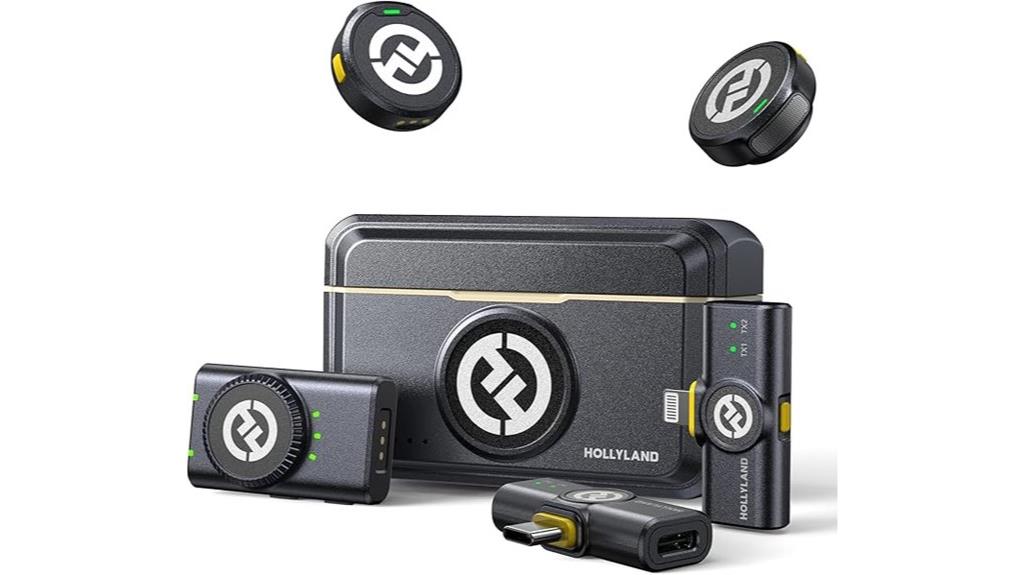
The Hollyland Lark M2 Wireless Lavalier Microphone stands out as a premier choice for content creators and professionals seeking high-quality audio without breaking the bank. With compatibility across multiple devices including iPhones, Androids, cameras, and laptops, this microphone caters to a wide range of users. Its standout features include a remarkable 48kHz, 24Bit audio quality and a substantial 70dB signal-to-noise ratio, ensuring crystal-clear sound capture. The compact and lightweight design, weighing just 9g, makes it the lightest mini microphone available, enhancing portability without compromising performance. Furthermore, the Lark M2 boasts an impressive 1000ft line-of-sight wireless range and up to 40 hours of battery life with its charging case, making it reliable for extended use in various settings.
Best For: Professionals and enthusiasts in digital content creation who need a lightweight, high-quality audio solution for various multimedia projects.
Pros:
- Exceptional audio quality with 48kHz, 24Bit resolution and a 70dB signal-to-noise ratio.
- Ultra-lightweight and compact design, making it highly portable and unobtrusive.
- Long battery life with up to 40 hours via the charging case and a 1000ft wireless range.
Cons:
- Limited to mono and stereo modes, which may not satisfy all professional audio requirements.
- The noise cancellation feature, while effective, might not handle extremely loud environments.
- Dependence on the charging case for extended battery life could be inconvenient in situations without access to power.
Hollyland Lark M1 Wireless Lavalier Microphone System
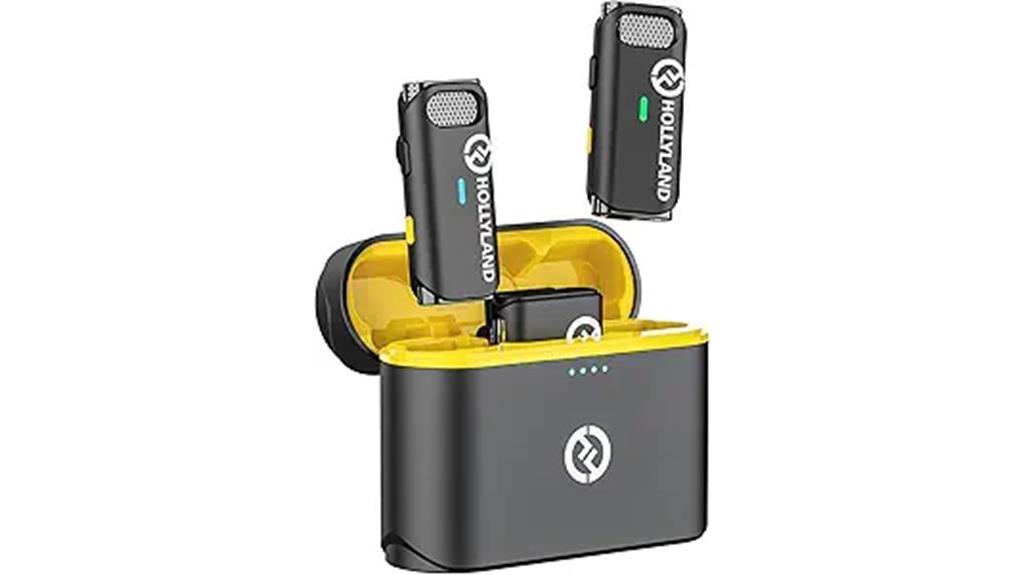
Ideal for content creators looking to produce crisp, clear audio without breaking the bank, the Hollyland Lark M1 Wireless Lavalier Microphone System stands out with its robust feature set. Offering a 656ft wireless transmission range, it supports high-fidelity audio, crucial for capturing clear sound in open spaces. The system features an 8-hour battery life with USB-C ports enabling charging during use, and weighs a mere 0.42oz, making it exceptionally lightweight and portable. Its one-click noise cancellation, powered by a DSP chip, ensures audio clarity even in challenging environments. This system is compatible with a broad range of devices including DSLRs and smartphones, making it versatile for interviews, podcasts, and outdoor shoots.
Best For: Content creators who need a lightweight, portable, and high-quality audio solution for various multimedia projects.
Pros:
- Extended 656ft wireless transmission range and high-fidelity sound capture.
- 8-hour battery life with the convenience of USB-C charging during use.
- Effective one-click noise cancellation feature for clear audio in noisy environments.
Cons:
- Does not include a TRRS cable, which is necessary for connectivity with some devices.
- Some users have reported issues with the strength of the microphone clip and windscreen attachment.
- Lack of a digital display for monitoring battery levels and volume settings.
Logitech Blue Yeti USB Microphone for PC and Mac
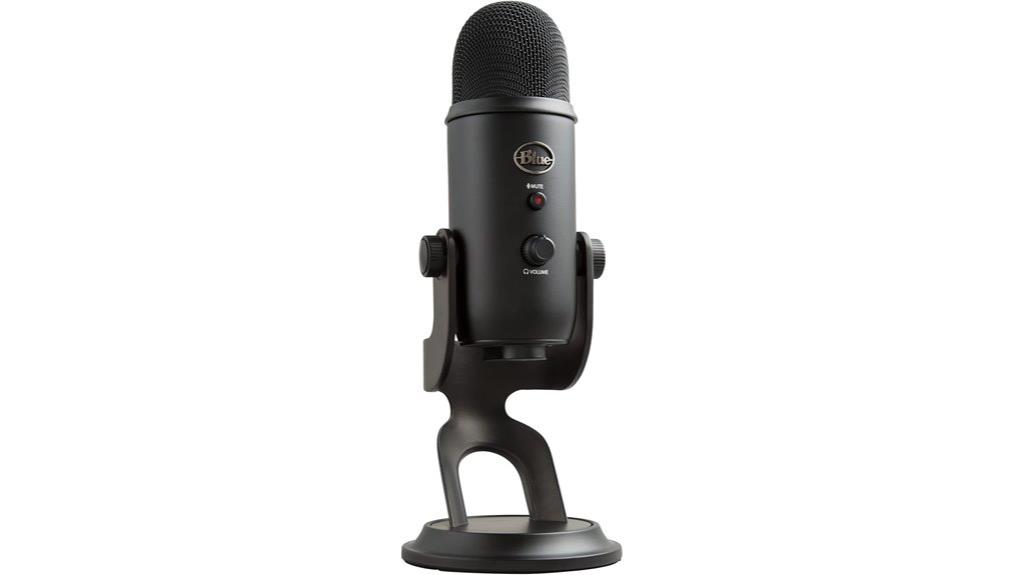
For avid gamers, podcasters, and digital content creators, the Logitech for Creators Blue Yeti USB Microphone stands out as a top choice under $150. This microphone offers a custom three-capsule array that delivers broadcast-quality sound, ideal for a range of applications from streaming to professional recording. Its versatility is enhanced by the Blue VOICE software, which provides advanced vocal effects and HD audio samples. Additionally, users can select from four pickup patterns—cardioid, omni, bidirectional, and stereo—making it adaptable for different recording environments.
The Blue Yeti also boasts a sleek design with an adjustable desktop stand and onboard controls for volume, pattern selection, and mic gain, ensuring optimal usability and sound quality. Its plug-and-play feature simplifies setup, making it immediately functional with both PC and Mac without the need for drivers. With over 34,000 positive ratings, it promises durability and consistent performance, making it a commendable choice for anyone looking to invest in a reliable microphone on a budget.
Best For: Content creators and professionals seeking a versatile, high-quality USB microphone at an affordable price.
Pros:
- Offers four different pickup patterns for versatile recording settings.
- Includes Blue VOICE software for professional-grade vocal effects and audio customization.
- Quick and easy setup with plug-and-play compatibility for both PC and Mac.
Cons:
- May require additional pop filters or shock mounts for optimal audio quality.
- Heavier and bulkier compared to other portable microphone options.
- Limited color options, primarily available in a blackout finish.
HyperX QuadCast S RGB USB Condenser Microphone
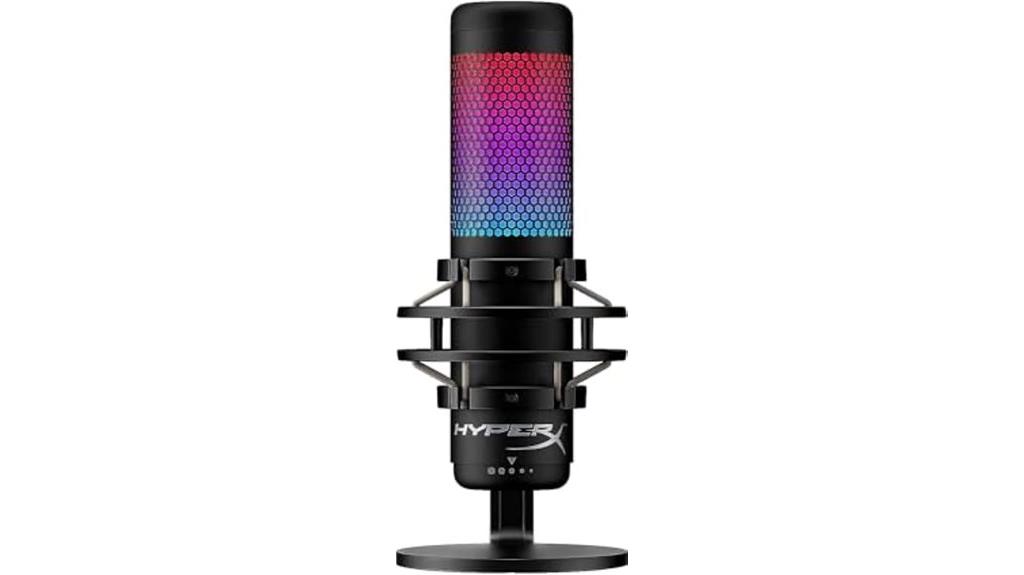
Gamers and streamers looking for superior audio quality without breaking the bank will find the HyperX QuadCast S RGB USB Condenser Microphone an exceptional choice. Released by HP Inc., this microphone boasts a robust rating of 4.7 out of 5 stars from nearly 20,000 users and shines in versatility and performance. It features customizable RGB lighting, four polar patterns for varied recording needs, and integrated anti-vibration shock mount and pop filter to enhance sound clarity. The plug-and-play functionality ensures easy setup, while real-time audio monitoring through a headphone jack offers immediate feedback. Certified by Discord and TeamSpeak, its reliability and crisp audio output make it ideal for professional-level broadcasting on any platform.
Best For: High-quality audio enthusiasts like streamers, gamers, and podcasters who appreciate versatile recording options and customizable aesthetics.
Pros:
- Customizable RGB lighting and adjustable polar patterns cater to both functional and aesthetic preferences.
- Built-in shock mount and pop filter significantly improve sound quality by reducing unwanted noise.
- Plug-and-play functionality paired with real-time audio monitoring simplifies setup and use.
Cons:
- Limited to USB connection, which may not suit all professional recording or audio engineering needs.
- RGB lighting, while aesthetically pleasing, might be unnecessary for users focused solely on audio functionality.
- The microphone's weight and size could be cumbersome for those with limited desk space.
Rode PodMic Cardioid Dynamic Broadcast Microphone, Black
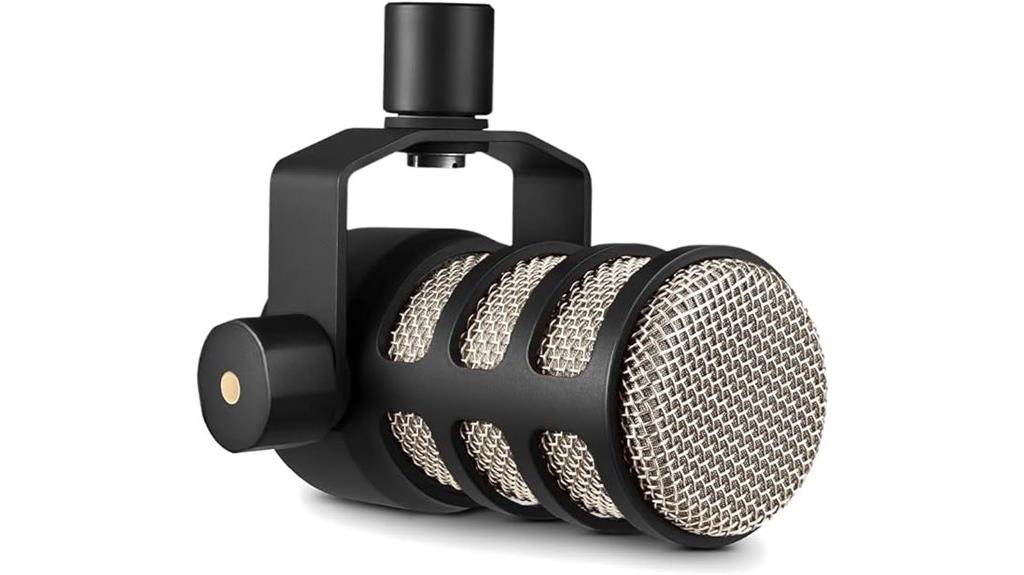
The Rode PodMic Cardioid Dynamic Broadcast Microphone stands out in the sub-$150 market, particularly for podcasters seeking professional-grade sound quality without breaking the bank. Engineered specifically for podcasting, this dynamic microphone is built with a sturdy metal body, ensuring durability. It features a tight cardioid polar pattern that effectively rejects background noise, and an internal pop filter and shock mount that minimize plosives and vibrations, respectively. The microphone's rich, balanced sound profile captures voices with clarity and warmth, making it a favorite among users, as reflected in its high ratings. Although it requires a bit more gain due to its low output, its performance when paired with appropriate interfaces like the RODECaster Pro is exceptional. Priced around $99, it offers remarkable value in the budget microphone segment.
Best For: Podcasters and broadcasters looking for a durable, high-quality microphone at an affordable price.
Pros:
- Optimized for vocal clarity with an internal pop filter and shock mount that control plosives and vibrations.
- Sturdy metal construction enhances durability and provides a professional look.
- Tight cardioid polar pattern effectively isolates speaking voices from background noise.
Cons:
- Requires a higher gain setting due to its low output, which may necessitate additional equipment.
- Does not include a built-in headphone jack for direct audio monitoring.
- Accessories like a pop filter and mic arm are not included and must be purchased separately.
Factors to Consider When Choosing Microphones Under $150 in 2025
When selecting a microphone under $150 in 2025, several key factors merit attention to ensure optimal performance and value. Considerations should include not only audio quality standards and noise cancellation features but also the device's compatibility with other equipment, its design and portability, and battery efficiency. Each of these aspects plays a crucial role in determining the overall effectiveness and suitability of a microphone for both amateur and professional users.
Audio Quality Standards
Understanding audio quality standards is crucial when selecting microphones priced under $150. Key metrics include frequency response, signal-to-noise ratio (SNR), bit depth, and sampling rate, each playing a pivotal role in the overall sound quality. An optimal frequency response for capturing the full auditory range of human hearing spans from 20Hz to 20kHz. This broad range ensures that both the low bass tones and high treble notes are accurately reproduced, which is essential for both spoken word and musical performances.
A high SNR, preferably at least 70dB, is critical as it determines how well the microphone can distinguish sound from background noise. The higher the SNR, the clearer the audio output, making it easier for listeners to focus on the intended sound without distractions.
Moreover, a 24-bit depth is advisable for professional-level clarity, offering a significant dynamic range that enhances the audio's fidelity. Similarly, a minimum sampling rate of 48kHz is recommended to ensure detailed and crisp sound capture, especially important in complex audio environments.
Lastly, modern microphones under $150 increasingly incorporate noise cancellation technologies. These features are vital for reducing ambient sounds, thereby sharpening the focus on the primary audio source and improving recording quality in diverse settings.
Compatibility Options
Choosing the right microphone under $150 requires careful consideration of compatibility options to ensure it works seamlessly with your intended devices. When selecting a microphone, it's crucial to verify that it aligns with the types of devices you plan to use, whether PCs, Macs, smartphones, or cameras. This ensures that the microphone will integrate smoothly into your existing setup without the need for additional adapters or software.
Microphones offering a variety of connection types such as USB, XLR, or TRS/TRRS cables are particularly valuable. These options increase the microphone's versatility, allowing it to function across different systems and recording environments. For those seeking ease of use, microphones featuring plug-and-play functionality or pre-pairing capabilities are advantageous. This simplifies the setup process, reducing the time and effort spent on troubleshooting potential connectivity issues.
Furthermore, selecting a microphone that supports multiple polar patterns can greatly enhance its adaptability. This feature is beneficial in various recording conditions, from quiet studios to noisy field environments. Additionally, compatibility with audio enhancement software or monitoring applications is essential for improving the audio quality and enriching the overall user experience.
Design and Portability
After considering compatibility, another vital aspect to assess when selecting a microphone under $150 is its design and portability. Lightweight and compact microphones offer significant advantages for creators who are always on the move. Models weighing around 9g are particularly beneficial as they are easy to carry and less noticeable during use, which can be crucial in dynamic recording environments.
A compact design not only makes a microphone less cumbersome but also enhances its suitability for travel. Microphones that are about half the size of traditional models are especially convenient for on-the-go recording, fitting easily into backpacks or even pockets. This portability is further complemented by user-friendly features like plug-and-play setups, which eliminate the need for additional equipment and simplify the connection process.
Moreover, the build quality is an essential factor to consider. Durable materials are pivotal in ensuring that the microphone can endure frequent handling and transportation without damage, thereby extending its life. Additionally, microphones that include integrated charging cases offer further convenience by enabling quick recharging capabilities and substantially extending usage time between charges, making them ideal for extended recording sessions away from power sources.
Battery Efficiency
Battery efficiency stands as a cornerstone for those seeking reliable portable microphones under $150, particularly when uninterrupted usage is essential during prolonged recording sessions or events. As creators increasingly rely on mobile setups, the significance of a microphone's battery life becomes paramount. Models offering up to 10 hours of continuous usage are available, while others may only sustain 8 hours. This variance highlights the importance of checking battery specifications to ensure they meet your recording needs.
Moreover, charging features significantly enhance a microphone's appeal. USB-C ports, for instance, allow for simultaneous charging and usage, a vital feature for creators who cannot afford downtime. This capability ensures that even during extensive use, the microphone remains operational. Additionally, some microphones come with charging cases that provide multiple recharges, offering an extended total runtime of up to 40 hours. This is particularly beneficial for field recordings or events where power sources are scarce.
Lastly, the speed of recharging is a crucial factor. Fast-charging microphones, which replenish power in less than two hours, can be a game-changer in dynamic environments where time is of the essence, allowing for rapid readiness and minimal disruption.
Noise Cancellation Features
Noise cancellation features are essential for anyone looking to produce high-quality audio recordings in less-than-ideal environments. As creators increasingly operate in dynamic settings, the ability to isolate the desired audio source becomes paramount. Noise cancellation helps in reducing ambient sounds, ensuring that the main audio is crisp and clear. Today's efficient microphones under $150 often include one-click noise cancellation capabilities, allowing for quick activation to combat unexpected background noise.
Incorporating Digital Signal Processing (DSP) chips, these microphones further enhance noise reduction by intelligently filtering out background disturbances. This technology is particularly beneficial in windy or chaotic environments where maintaining audio clarity is challenging. However, the effectiveness of noise cancellation varies widely among budget-friendly microphones. Some models excel at minimizing background interference, providing a near-professional level of audio isolation, while others may offer only basic improvements.
Potential buyers should consider the noise level specifications of a microphone, typically measured in decibels (dB). This metric helps gauge how well a microphone can handle unwanted sounds, a critical factor for creators who need dependable audio quality in unpredictable scenarios.
Ease of Setup
While noise cancellation is a key feature for microphones used in challenging environments, another important aspect to consider is the ease of setup. For creators on the go or those operating in a home studio, the ability to quickly and efficiently set up a microphone can significantly enhance productivity and reduce frustration.
Opting for microphones that boast plug-and-play functionality is highly recommended. These devices eliminate the need for intricate installation procedures or downloading specific drivers, enabling you to start recording almost immediately after unboxing. Additionally, microphones with user-friendly controls, such as onboard knobs for volume adjustments and pattern selection, further simplify the operation. This is particularly beneficial during sessions where quick adjustments are necessary.
Furthermore, for those opting for wireless solutions, selecting a microphone with instant pairing capabilities can save valuable time. Such features ensure that devices connect swiftly without cumbersome setup steps. Also, microphones that include visual indicators, like LED status lights, provide immediate, at-a-glance information about the microphone's status, which is crucial during live recordings.
Lastly, choosing a microphone that supports multi-device compatibility not only streamlines the setup process but also avoids the clutter and expense of additional cables and adapters, making it an ideal choice for creators using multiple platforms.
Durability and Build
Durability and build quality are crucial considerations when selecting a microphone under $150, particularly for users who frequently travel or engage in on-location recordings. The construction material plays a significant role in the lifespan and robustness of the microphone. Generally, models crafted from metal are more durable and better suited to withstand the rigors of frequent use and varied environmental conditions than their plastic counterparts.
The weight of the microphone also serves as a useful gauge of its sturdiness. Heavier microphones typically incorporate superior shock mounting systems and more solid overall construction, which can significantly reduce the risk of damage from accidental drops or bumps. Additionally, internal shock mounts are essential as they minimize vibrations and handling noise, thus preserving the microphone's integrity and performance over time.
Another factor to consider is the microphone's compatibility with mic stands. A well-designed compatibility feature ensures the microphone can be securely mounted, reducing the likelihood of falls or mishandling. Lastly, consulting user reviews that focus on durability and build quality can provide valuable insights from real-world usage, offering a clearer picture of how well a microphone might hold up under regular travel and use conditions.
Conclusion
In conclusion, the array of microphones available under $150 in 2025 demonstrates significant advancements in affordability without compromising on quality. The selection, ranging from the versatility of the Logitech Blue Yeti to the dynamic performance of the Rode PodMic, caters to a diverse array of creators. Such options ensure that high-quality audio production is accessible to all, fostering a more inclusive environment for content creators across various media platforms. This democratization of technology is pivotal for nurturing emerging talent in the digital landscape.










